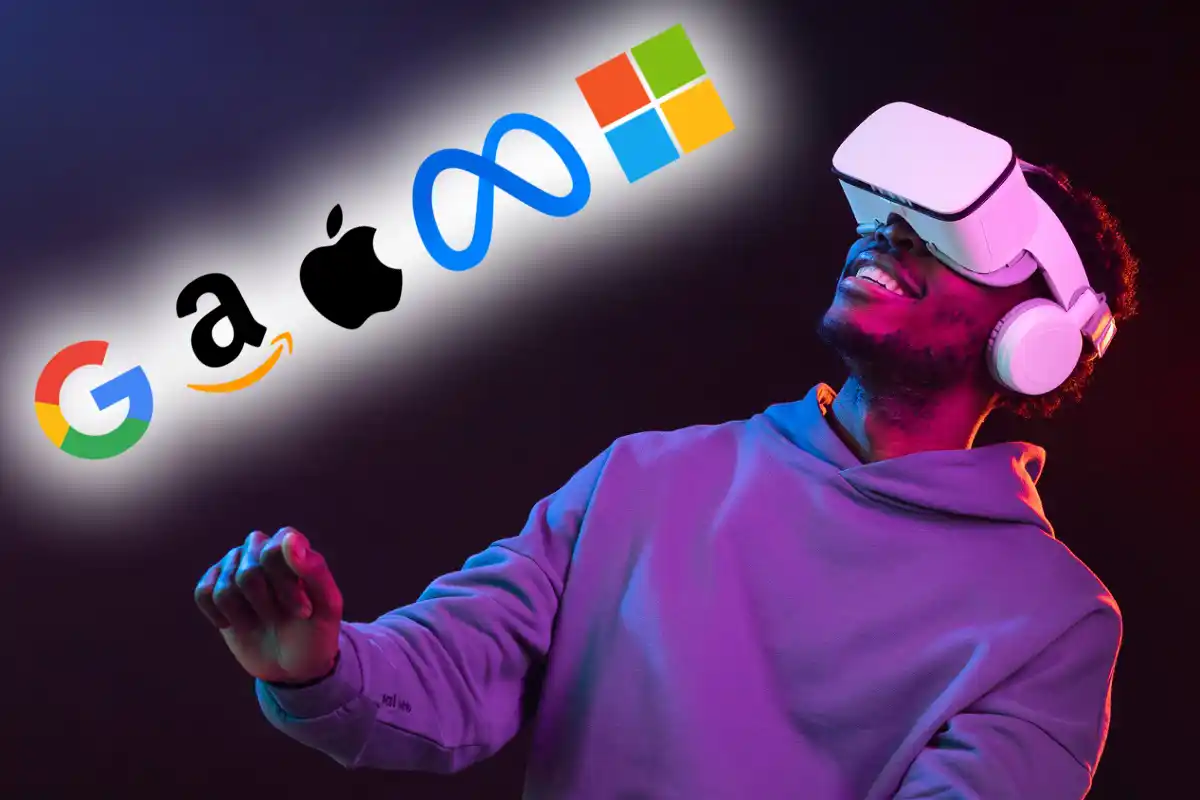Welcome to the exciting world of Web3, a technological revolution that’s reinventing the internet as we know it. Web3, often referred to as the decentralized web, signifies the next stage in internet evolution.
It aims to transform the way we interact, connect, and exchange value online, pushing the boundaries of what’s possible.
The potential of this technology hasn’t gone unnoticed, with many heavyweights in the tech industry, including Google and Microsoft, delving into Web3 projects.
Big tech’s involvement in Web3 represents a significant shift towards a more open and user-centric digital landscape. These companies are investing heavily in Web3 technology, acknowledging its potential to disrupt traditional systems and create a more secure, transparent, and equitable digital world.
For instance, Google Web3 initiatives are focused on exploring the potential of decentralized systems and blockchain technology. They’re developing new ways for users to interact with the digital world that puts control back in the hands of the individuals.
Likewise, Microsoft’s foray into Web3 also centers around leveraging blockchain technology, offering new ways to store and exchange information securely. Microsoft Web3 projects are just one example of how the tech titan is embracing this new frontier, eager to uncover its transformative potential.
This push towards Web3 isn’t just about adapting to the latest technology; it represents a broader shift in the way we think about online interactions. The Web3 Innovations brought forth by these tech giants are poised to change our digital experiences fundamentally, making them more secure, transparent, and user-centric.
This blog aims to delve deeper into the intriguing world of Web3. We’ll explore how big tech is investing in Web3, the significance of their initiatives, and the potential future of this technology.
So buckle up and get ready to explore the new frontier of the internet – Web3!
Understanding Web3
In the most straightforward terms, Web3 or Web 3.0 is often referred to as the next-generation internet or the ‘decentralized web’. It’s an upgrade from the current version of the internet, known as Web2 or Web 2.0. Web3’s underlying principle revolves around a decentralized network and cutting-edge technologies like blockchain, smart contracts, and decentralized finance (DeFi).
What makes Web3 distinct and revolutionary is its emphasis on decentralization and user sovereignty. Unlike Web2, which centralizes data control in the hands of a few dominant platforms, Web3 promises an internet where users have full ownership and control over their data. Also, Web3 enables direct peer-to-peer interactions without needing intermediaries, thanks to blockchain technology.
10 Web3 Trends to Watch in 2023
Web3’s potential is enormous and goes beyond just user data control. It paves the way for a host of technological advancements like decentralized applications (dApps), NFTs (Non-Fungible Tokens), and DAOs (Decentralized Autonomous Organizations), offering a whole new level of digital interactions.
The transition from Web2 to Web3 is not just about advanced technology; it’s about a shift in power dynamics. In Web2, tech giants like Google and Facebook control user data, a model that has sparked privacy concerns and calls for better data ownership rights. Web3 aims to address these concerns by returning data control to the users, fostering a digital world based on transparency, privacy, and user empowerment.
Understanding the differences between Web2 and Web3, and why this evolution matters, is crucial for anyone interested in the future of the internet. Web3 doesn’t just represent a technological shift; it also signifies a move towards a more democratic and user-centric digital world.
With all of this in mind, it’s clear to see why big tech companies are investing so heavily in Web3 projects. As we delve deeper into this topic, we’ll explore these investments and the significant impact they could have on the future of the internet.
Meta’s Venture into Web3
When we talk about big tech’s foray into the world of Web3, Meta Platforms, formerly known as Facebook Inc., undoubtedly stands out. The tech titan has taken a bold leap into the next-gen internet with a series of innovative Web3 projects.
Their main objective?
To transform the way we interact, work, and socialize online through a concept they’ve dubbed the ‘Metaverse’.
At its core, the Metaverse represents a convergence of the physical and digital worlds. It’s an immersive, 3D virtual environment where people can interact with each other in real-time, regardless of their physical location. It aims to provide a more interactive, immersive, and inclusive form of online experience that goes beyond what Web2 can offer.
The technology behind Meta’s Web3 projects is complex, utilizing a blend of blockchain, virtual reality (VR), augmented reality (AR), and artificial intelligence (AI). With these tools, Meta aims to create an interconnected web of virtual experiences, enabling users to move seamlessly between different virtual environments.
Meta’s strategy in venturing into Web3 is pretty clear. They aim to be at the forefront of the Metaverse evolution, shaping and defining the standards of this new digital frontier. By doing so, Meta hopes to secure its position as a dominant player in the Web3 space, just as it has in the Web2 era.
With the introduction of the Metaverse, Meta is taking significant strides to realize the full potential of Web3.
However, it’s crucial to note that their vision is still in its early stages. The true impact of Meta’s Web3 projects, and how they’ll reshape our online experiences, is something that will unravel with time. In the following sections, we’ll delve deeper into other tech giants’ initiatives in the realm of Web3.
Google’s Exploration of Web3
As a dominant player in the Web2 landscape, Google is unsurprisingly taking significant strides in the evolving Web3 ecosystem. Their exploration of Web3 primarily revolves around leveraging blockchain technology and cloud computing to create more secure, transparent, and user-empowering digital experiences.
One notable initiative by Google in the Web3 space is their partnership with blockchain companies and protocols. Google Cloud has integrated with various blockchain networks, providing infrastructural support to help these networks scale more efficiently. This not only signals Google’s recognition of blockchain as a key technology behind Web3 but also allows them to be a part of the foundational infrastructure of the new web.
Google Cloud Partners With BNB Chain to Provide Web 3 Startup Infrastructure
Furthermore, Google has also been actively involved in research and development related to quantum computing and its potential applications in the blockchain space. This cutting-edge technology holds the potential to dramatically increase the speed and security of blockchain networks, a crucial aspect of the Web3 evolution.
In terms of features, Google’s projects aim to provide better data security and privacy, a key promise of Web3. They’re also investing heavily in user interface design to ensure that Web3 technologies are as accessible and user-friendly as possible.
It’s clear that Google’s approach to Web3 is a blend of collaboration, innovation, and inclusivity. The tech giant is not just riding the Web3 wave, but is actively contributing to shaping it, showing its commitment to stay at the forefront of internet evolution.
In the following sections, we’ll discuss how other big tech players are stepping into the Web3 domain, contributing their unique strengths and visions to this burgeoning digital landscape.
Microsoft’s Journey towards Web3
Microsoft, a veteran in the tech industry, has always been quick to adapt to evolving technologies. Its journey towards Web3 is no different. The tech titan is actively exploring Web3, marking a strategic move to stay ahead in the dynamic digital era.
Microsoft’s involvement in the Web3 space is diverse and far-reaching. They’re focusing on both blockchain technologies and decentralized identity solutions, aiming to make digital interactions more transparent, secure, and user-centric. Microsoft’s Azure Blockchain Service and ION, their decentralized identity solution, are remarkable examples of their efforts in the Web3 space.
The Azure Blockchain Service is a fully managed blockchain service that simplifies the formation, management, and governance of consortium blockchain networks. It allows businesses to focus on workflow logic and app development rather than dealing with the intricacies of maintaining a blockchain infrastructure. This technology forms a cornerstone of Microsoft’s Web3 approach, enabling businesses to build applications with distributed ledger technology.
ION, on the other hand, is a decentralized identity solution built on top of the Bitcoin network. It provides users with self-owned identifiers, increasing privacy and security when interacting online. This approach represents a radical departure from the traditional model where identities are managed by centralized authorities.
In terms of features, Microsoft’s Web3 projects aim to create a more decentralized, transparent, and secure internet. They’re dedicated to promoting user empowerment, privacy, and interoperability, which are key pillars of the Web3 ethos.
Microsoft’s journey towards Web3 demonstrates their commitment to reshaping the future of the digital landscape. They’re not just adopting the new web, but actively shaping it with their unique strengths and expertise.
In the following sections, we’ll explore how other big tech companies, such as IBM, are investing in Web3, contributing to the rapidly changing landscape of the internet.
IBM and Other Tech Giants’ Web3 Initiatives
IBM has long been a front-runner when it comes to technological innovation, and they’re no stranger to the realm of Web3. The tech giant has been heavily involved in blockchain technology, one of the foundational pillars of Web3.
Their notable project in this space is the IBM Blockchain, a platform that facilitates the development of decentralized applications (dApps) and networks.
IBM Blockchain is aimed at enabling businesses to create highly secure, transparent, and efficient digital systems using blockchain technology. The platform allows organizations to build, deploy, and manage blockchain networks on a scalable and secure infrastructure. It also offers features like end-to-end encryption and secure service containers for enhanced security.
On the other side, tech giants like Amazon and Apple are not far behind. Amazon, through its cloud computing subsidiary, Amazon Web Services (AWS), provides a range of blockchain solutions.
AWS Blockchain Templates allow developers to create and deploy secure blockchain networks using popular open-source frameworks, enabling rapid prototyping and development of Web3 applications.
Apple, on the other hand, while relatively quiet about its plans for Web3, has shown interest in the blockchain technology and is known to have multiple patents related to blockchain. It’s likely that they’re exploring ways to integrate Web3 technologies into their ecosystem to enhance user privacy and data security.
These initiatives by IBM, Amazon, Apple, and other tech giants underscore the industry’s significant interest in Web3. Each company brings its unique approach and strength to the table, driving the development of Web3 forward and shaping the future of the internet.
As we delve deeper into this blog, we’ll look into the broader implications of these investments and what they mean for the future of Web3 and the digital landscape.
Comparison of Big Tech’s Web3 Projects
As we delve into the world of Web3, it’s interesting to see how each tech giant is taking its unique approach to harness its potential. Let’s compare these approaches and analyze the potential impact of these projects.
Starting with Meta (formerly Facebook), the company is making waves with its “metaverse” concept. This immersive, VR-based social experience aligns with Web3’s principles of decentralization and peer-to-peer interactions. It aims to create an all-encompassing digital universe that could redefine how we interact online. The potential of Meta’s project is immense, particularly in terms of social connectivity and digital economies.
Google, the internet search giant, is using its strengths in data processing and cloud computing for its Web3 initiatives. Their focus is more on creating a robust infrastructure for Web3 applications, assisting developers in building and deploying blockchain networks with Google Cloud. This approach can accelerate the adoption of Web3 technologies across various sectors.
Microsoft is leveraging its expertise in software and cloud services for its Web3 journey. The company’s blockchain-as-a-service (BaaS) offering, Azure Blockchain Service, allows businesses to build, manage, and govern consortium blockchain networks. It aims to simplify the process of building Web3 applications, reducing the technical barriers for adoption.
IBM, a long-time leader in blockchain technology, is focusing on developing enterprise-grade solutions. The IBM Blockchain platform is designed to provide businesses with a secure and efficient way to implement blockchain networks, enhancing transparency and trust.
Looking at the competitive landscape, it’s clear that each company is playing to its strengths. While they’re all embracing the principles of Web3, the focus areas differ – Meta on social interactions, Google and Microsoft on infrastructure, and IBM on enterprise solutions.
This competition is set to spur innovation and accelerate the development and adoption of Web3 technologies. As these projects evolve, they are likely to redefine the digital landscape, making Web3 a new standard for the internet.
Challenges and Opportunities in Web3
Despite the exciting possibilities, the journey into Web3 isn’t without its challenges. For big tech companies like Meta, Google, Microsoft, and IBM, navigating the Web3 landscape means tackling several key obstacles.
But on the flip side, these challenges also open up immense opportunities.
One significant hurdle is the technical complexity of Web3 technologies. Building decentralized networks, ensuring data privacy, and maintaining network security are just some of the tasks that demand considerable expertise. It can also be challenging to create user-friendly interfaces that hide this complexity from end-users.
As such, tech companies with a knack for simplifying complex technologies and making them accessible stand to gain the most in the Web3 space.
Regulatory challenges are another major concern. As Web3 technology often involves cryptocurrencies and other digital assets, companies need to navigate a complex and often uncertain regulatory landscape. But those who can effectively liaise with regulators and build compliant solutions could set a precedent, encouraging others to follow suit and further mainstreaming Web3.
On the brighter side, the opportunities in Web3 are virtually limitless. The technology can revolutionize everything from social media (as Meta is aiming to do) to finance, supply chains, and more. It offers a chance to create more equitable and decentralized digital spaces, a prospect that is exciting for both tech companies and end-users alike.
In terms of the future, Web3 has the potential to become the new internet standard. It promises a future where users have more control over their data, where services are more transparent and equitable, and where the digital and physical worlds blend seamlessly.
For tech giants, embracing Web3 could mean shaping the future of the internet, offering a once-in-a-lifetime opportunity to make their mark on the digital landscape.
Conclusion
As we wrap up our deep dive into the exciting world of Web3 and the big tech companies making waves in this space, let’s revisit some key takeaways.
We’ve seen how Web3, with its decentralized and user-centric model, is setting the stage for the next evolution of the internet. Tech giants like Meta, Google, Microsoft, and IBM are investing heavily in this space, each with their unique approach, whether it’s creating a metaverse or revolutionizing data privacy and security.
The race to Web3 among these companies is leading to some fascinating projects, each leveraging groundbreaking technology to bring the benefits of Web3 to users worldwide. While there are significant challenges to be overcome, such as technical complexities and regulatory hurdles, the opportunities Web3 presents are vast and potentially transformative.
Looking towards the future, we can expect this race to Web3 to reshape not just the internet, but also the tech industry at large. The winners of this race might not only lead the way to a more decentralized, equitable digital world but also set the standard for the industry’s next big leap.
As we move forward, the commitment of these companies to Web3 innovations will undoubtedly continue to be a key trend to watch, marking an exciting new chapter in our digital journey.


